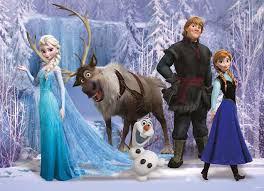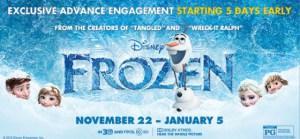If you weren’t clear about this until now we can now officially be impressed by the box office performance of Frozen. When a movie somehow climbs back up to the #1 spot on the weekend top 10 chart in its sixth weekend that is when you should stop and applaud. Why? For starters, that kind of thing almost never happens. Plus, the last movie to even be at #1 in its sixth weekend was Avatar. Frozen did it by making more money ($19 million) in its sixth weekend than any other film in history except for Titanic ($25 million) and Avatar ($34 million).
Frozen debuted this past Thanksgiving with a five-day weekend total of $93 million, second most for a film over Thanksgiving behind The Hunger Games: Catching Fire. At that time, online box office expert boxofficemojo.com concluded Frozen‘s opening meant “a final [domestic] total north of $250 million seems within reach.” Disney would have surely been happy with that, as it would have meant Frozen was a bigger domestic hit than their most recent non-Pixar releases: Wreck-It-Ralph ($189 million) and Tangled ($200 million).

Frozen is also breaking overseas records, the top-grossing Disney and Pixar release of all time in Russia ($29.3 million) and top-grossing Disney Animation release ever in the U.K. ($50.4 million). It has yet to open in Japan and China, which together represent around 17% of the global marketplace for movies. As a result, it will likely pass Monsters University ($743 million) to become the second highest worldwide grossing animated film of 2013 behind Despicable Me 2 ($921 million).
Its soundtrack is also turning into quite the hit, unseating Beyonce to become the #1 selling album this past week according to the Billboard Top 200 albums chart. Only three animated film soundtracks had reached #1 before: “Curious George” (2006), “Pocahontas” (1995), and “The Lion King” (1994).
How did this happen? The ultimate explanation is simply that Frozen is a fantastic movie that everyone seems to love with minimal to no reservation. It sure melted our reviewer’s heart (mine was a bit more thawed than melted, but it’s still a great movie). However, there are plenty of great movies that don’t make this kind of money, if they’re lucky to even make money at all. What is it exactly about Frozen?
Time of the Year? Disney has made a habit of putting out animated films in November, going back to Chicken Little in 2005. However, simply coming out around Thanksgiving so that your target audience-kids-will be out of school was not enough to elevate Chicken Little, Bolt, Tangled, or Wreck-It-Ralph into hits anywhere near the level of Frozen.
No Competition? Yes, Walking with Dinosaurs bombed, but the animated film competition the prior Disney November releases faced all turned out to be financial disappointments, Tale of Desperaux against Bolt, Yogi Bear against Tangled, and Rise of the Guardians against Wreck-It-Ralph.
The Weather? It’s cold and snowy outside, with plenty of snow storms plaguing various regions of North America over the past month. Well, Frozen has a bunch of snowcapped mountains in it, and features a plot involving a dangerous magical ice storm. Does that mean Frozen seemed all the more relevant to audiences? It has the ring of truthiness to it, but giving us a movie featuring a lot of snow when its snowy outside doesn’t equal big business (look at the 2006 Black Christmas re-make).
The Marketing? Here’s where you probably find some actual answers. Disney’s strategy with marketing Frozen, at least early on, was to completely hide the type of movie it was. Look at the first official trailer, which also aired repeatedly during commercial breaks on the Disney Channel:
Based upon that trailer, you’d think Frozen was going to be kind of like Wall-E meets Ice Age. If that confused us adults what must little kids have thought? The funny thing is the scene highlighted in that trailer? It’s not actually in the movie.
It was a while before Disney acknowledged that Frozen featured not only actual human characters but two all new Disney princesses.

This was kind of risky because they sold it on Olaf, and he doesn’t show up until halfway through the movie. Plus, they pretended like it was an absolutely normal animated kids movie, hoping audiences wouldn’t mind when they showed up to find out it was actually a musical. They did the same exact thing with Tangled, which is not nearly as jam-packed with songs as Frozen.
Even with the success of Les Miserable last year, studios still clearly feel that mainstream audiences have to be tricked into watching a musical rather than enticed. Considering that practically every other wretched live action show on Disney Channel features characters who sing (and how central the original songs are to their hit animated show Phineas & Ferb), Disney has done more than enough to prepare their target audience for a musical. Their marketing department disagreed. The only kind of hint they offered as to the film’s musical nature was a heavily utilized quote from an early review which argued Frozen was the best Disney animated film since The Lion King, which we all know is a musical.
So, did Disney just get lucky? Well, they had that huge opening, and if audiences had truly felt misled there would have been a significant drop-off after that, which didn’t happen. Their marketing was undeniably misleading but it also, refreshingly, gave hardly anything away. They tricked us into going to see the cute, funny snowman and broke our hearts with an incredibly unexpected tale of two sisters who drift apart due to a magical curse – and then the snowman shows up.
Word Of Mouth? Disney’s marketing machine can only do so much. What’s driving Frozen has been strong word-of-mouth, which is still regarded as being among the most important elements to a film’s box office performance. This annoys studios because that’s also the type of thing you can’t really buy. However, Frozen has had it in abundance ever since critics got their first look at it several weeks before its release, collectively crowning it an instant Disney classic the types of which we hadn’t seen in decades.
Ever since its release, Disney has switched gears with their advertising, no longer hiding the true nature of their movie but giving newbies a look at what everyone was talking about by releasing two full scenes/songs from the movie.
Idina Menzel’s sure soon-to-be Broadway standard “Let It Go”:
And Olaf’s adorable “In Summer”:
So, basically, it all comes back to Frozen simply being a fantastic movie that audiences love so much they are clearly seeing it over and over again. Vulture took this point a step further and argued 7 specific reasons Frozen was resonating so much with audiences:
1. It’s a Throwback at a time when many other animation studios have become overly reliant on sequels and ultrahip, wiseass-y humor, Frozen stands out for its old-fashioned story — with its regal setting, its lonely princess in a castle, its kingdom under a spell — and for its visual splendor.
2. The Wisecracking Sidekick Wisecracking, irreverent sidekicks with a propensity for mild toilet humor (“Watch out for my butt!”) are basically a requirement of modern animated kids’ movies. Frozen, for all its above-mentioned throwback-y qualities, has got one, too, in the form of chatty snowman Olaf, voiced by The Book of Mormon’s Josh Gad. Luckily, his actions aren’t embarrassing, lowest-common-denominator high jinks. Olaf is adorable, and his dim antics are genuinely funny:
3. The Songs Frozen is an honest-to-God musical, a genre that, when done well, has an eager (and underserved) audience.
4. The “Villain” Structurally the person who should be the film’s villain is not a villain at all, but a heroine: Queen Elsa’s ability to freeze everything around her becomes a monstrous force, and she’s the one who, intentionally or not, creates most of the challenges the film’s more typical heroes — Princess Anna, especially — have to contend with. Elsa herself is not a villain, just a girl who’s having trouble coming to terms with her … well, with a lot of things.
5. A Resonant Tale With Real-life Overtones Frozen’s tale of an older sister who grows up and shuns her younger sister is a familiar dynamic to any child who’s had a sibling, or even in some cases a very close, older friend [...] This is a tale about growing up, becoming your own person, and learning not to be ashamed of yourself.
6. Girl Power! The Prince Charming of the tale — Prince Hans — turns out, at the very end, to be a gold-digging villain, and the true-love’s-kiss that Anna needs in order to be saved turns out to come from her own sister, Elsa. If that’s not a rebuke to the usual Disney true love narrative, I don’t know what is. That said …
7. Two Disney Princesses Girls do like the Disney Princesses, and Frozen’s got not one but two of them, and that’s kind of a big deal. And they’re both different in temperament. Anna’s the bright-eyed, romantic extrovert and Elsa’s the brooding, complicated loner. That broadens the movie’s already wide appeal considerably.
You hear that, filmmakers and advertisers? There are certainly elements of Frozen you can plunder, marking off similar check-boxes. However, if you make a truly astounding movie we will turn out to see it en masse even if, yes, your marketing kind of tricked us into it….at least at first.
What do you think? If you’ve seen Frozen, what got you to see it the first time? And when did you first discover it was actually a musical?

